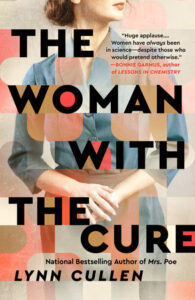
Research I’d Rather Not Have Done: Pandemics Then and Now
Lynn Cullen on Dorothy Horstmann, the Woman Behind the Polio Vaccine
The kernel for what would become The Woman with the Cure came to me back in 2015, while on my Friday walks with Albert Sabin biographer, Karen Torghele, who was then working as an oral historian for the Centers for Disease Control. It was Karen, with her eye-popping tales of public health pioneers, who whetted my interest in the race for the polio vaccine. A book begged to be written about the all-too-human antics of those gods with clay feet, Drs. Jonas Salk and Albert Sabin, in their cutthroat race to be the first to find the vaccine.
It would be four years until the writing commenced, and another good portion of a year after that for the story to take off. I wanted to tell the story from a woman’s point of view, and I couldn’t find my heroine. Although many women made crucial advances in the drive to beat polio—actually a woman, Isabel Morgan, created the first modern polio vaccine, Salk only modified it—I had to root them out. Women in science in midcentury America are truly hidden figures.
I tried out various protagonists but Dr. Dorothy Horstmann, who started out as a minor character, kept stealing the show. Born in 1911 to poor German immigrants who worked in a bar, Dorothy should have never amounted to anything. She had to supplement the family pot by giving piano lessons as a teenager—at sixteen, she had her own listing in the US Census as a music teacher. She earned a degree in English Literature then went to medical school at a time when few women did, especially not poor ones. Vanderbilt University Hospital only accepted her as a resident when the chief thought that the D.M. Horstmann on a stellar resume was a man. (It delighted her for years to describe how the dean went “nearly apoplectic” when Dorothy Millicent Horstmann walked in the door.)
She had to talk her way into her fellowship at Yale, when her interviewer reported that he’d had a bad experience with the one female he’d hired and he was never employing one again. She asked him if he’d hold one man’s mistakes against every other man who came after him for the next fifty years. He begrudgingly hired her.
She taught at Yale for the rest of her life, serving for many years on the Yale Polio Study Unit, the flying epidemiology squad sent to outbreaks across the world. Several decades into her employment there, she became the first women with a full professorship in the medical school—although that elevation only came after she was nominated for a Nobel Prize. Clearly, this was a woman who needed writing about!
Women in science in midcentury America are truly hidden figures.
Normally, as part of my research, I travel to the place of every scene in my books. It 1) adds to authenticity and 2) is fun. But this was early 2020. I got around it by setting my scenes in places I’ve already been. It was handy that in real-life, Dorothy had an affinity for Denmark and I’d just gone there the spring of 2019, and that she grew up and worked some in San Francisco, which I’ve often visited. But writing in the Time of COVID added an unsettling new twist: I got to actually live my research.
When we first hunkered into that initial lockdown, I was naïve as those crinolined ladies who’d brought picnics to watch the opening battles of the Civil War. I thought, this is terribly frightening, but at least the shutdown might end in maybe a week or two.
Several weeks later, with no end in sight and the agony of unrelenting isolation, sadness, terror, trauma, and grief setting in, I gained greater insight to the nightmare of the polio years.
Poliomyelitis claimed babies, toddlers, girls who’d just been roller-skating, teenaged boys playing football the day before, young mothers, young dads. Kids watched their buddies lose the use of their legs, siblings lost siblings, families were torn apart. And this went on for every summer forty years. Forty years! And the disease gained momentum over time. Scientists didn’t know how the polio virus worked in the body, nor how it spread. All parents had to battle it was isolation. Imagine their desperation.
Now we can.
No wonder children sent their dimes to President Roosevelt when he called for them to support polio research through the March of Dimes. The photo of FDR’s secretary buried at her desk under a silver landslide of coins that children had mailed in speaks to the public’s hope that scientists could save them. And scientists were trying. They knew that polio was caused by a virus, but how did it work in the body?
Early on, the most respected minds in the field theorized that the poliovirus entered through the nose and then somehow traveled directly to the spinal cord, where it paralyzed and killed—a theory based on what would turn out to be faulty research. After about twenty years, Albert Sabin proved that the poliovirus replicated in the gut, but neither he, nor anyone else, could say how it got from there to the spinal cord to do its dirty work—no one but Dorothy Horstmann, that is.
She suspected that poliovirus was found in the blood; that was how it traveled from the gut to the nerve cells it destroyed. But her hunch went against the theory then embraced by the great [male] minds in the field, so she got neither encouragement nor the funding to pursue it.
Meanwhile, Sabin blamed houseflies as the carriers. At his word, a massive program was launched to blanket the US with DDT sprayed from former military trucks and airplanes. (His theory was wrong.) In Sweden, doctors thought the virus was found in fruit that had fallen to the ground and sponsored a national rake-up. Another group of researchers figured it had to be in chickens’ spinal cords.
Private citizens had their own ideas, too, which they were happy to share with scientists, like the woman who dreamed that poliovirus lurked in beetles or groundhogs, she wasn’t sure which, and the man who was sure it could be cured with dog manure. Then there was the doctor in Berlin who claimed to have found success with injecting patients with their own urine, never mind the infection, the joint pain, the mental depression, the sore throat, and fever that resulted.
Knowing how long and how mightily scientists struggled to get a handle on polio only added to my awe when researchers were able to find a vaccine for COVID-19 in such short order. This is why, too, I’m patient as they tweak it as SARS-CoV-2 morphs. At least they have given us tools with which to fight our plague. All parents could do during the Polio Summers was to keep their kids out of pools and away from playgrounds, theaters, friends, life.
Living through a pandemic while writing about one certainly deepened my empathy for those earlier survivors.
Dorothy Horstmann never forgot those parents. It took ten long years of unencouraged persistence and meticulous research for her to confirm her hypothesis about poliovirus traveling through the bloodstream. But when she did, vaccine development surged forward. The end to Polio Summers was in sight.
Her impact on beating the disease didn’t stop there. When the results of the oral polio vaccine trial involving 11 million people in the USSR needed to be evaluated—single-handedly, mind you, because this was the height of the Cold War and the USSR would only allow in one Western scientist—who did the WHO turn to? Dorothy. The trial’s approval opened the door to the oral vaccine being used throughout the world. That polio vaccine that you got in a sugar-cube in the early 1960s? Essentially, you got it on Dorothy Horstmann’s say-so.
Perhaps Dorothy was disappointed that she had to share the honor of her discovery with David Bodian, who became interested in it many years after her first hypothesis. She never voiced her disappointment if she was. Nor did she ever say how upset she must have been to think how many children could have been saved if only her work had been enabled sooner.
We have photos now of children receiving their Salk polio shots with their happy mothers looking on, and of lines of children and parents patiently waiting for their dose of the Sabin oral vaccine. Few of us who queued up at school for our chance at a vaccine-laced sugar cube have forgotten it. Maybe we remember because of the excitement in the air. I can still feel it radiating through my school—so much fuss over a sugar-cube, although it was pretty tasty!
Maybe we remember because our mothers were so inexplicably (to our young selves) ferocious about us getting that sugar cube and were giddy once we’d taken it. But having lived through the time of COVID-19, I better understand the wonder and joy that came from receiving that first polio vaccine. I shed a few tears of gratitude and joy upon getting my first COVID shot, too.
Living through a pandemic while writing about one certainly deepened my empathy for those earlier survivors. I hope through my book to have accurately reported what it had been like for them, and for my readers, my fellow survivors, to know that someday our pain will be behind us, too—that, indeed, our suffering will be almost forgotten.
__________________________________

The Woman with the Cure by Lynn Cullen is available from Berkley, a division of Penguin Random House, LLC.
Lynn Cullen
Lynn Cullen grew up in Fort Wayne, Indiana, and is the bestselling author of The Sisters of Summit Avenue, Twain’s End, and Mrs. Poe, which was named an NPR 2013 Great Read and an Indie Next List selection. She lives in Atlanta with her husband, their dog, and two unscrupulous cats.



















